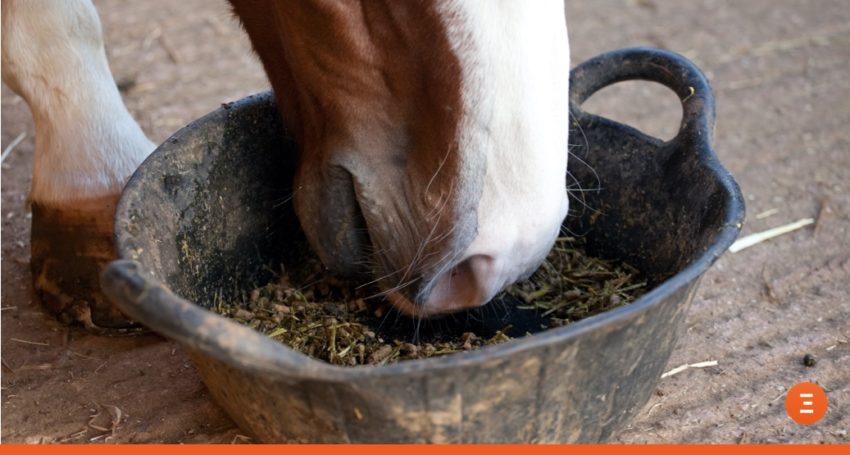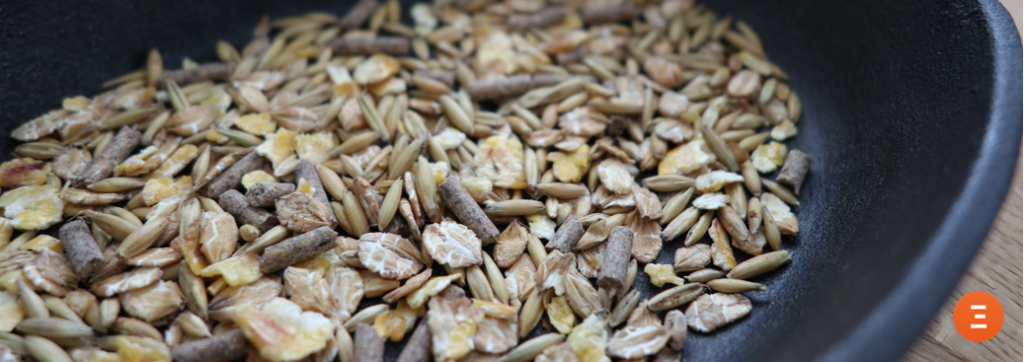
Starch content in horse feed: a value without value?
Excessive starch favors the appearance of certain pathologies (colic, ulcers, myositis, etc.): on this point, there is no debate! To avoid this, it is important to control the amount the horse ingests so as not to disrupt digestion. In this respect, the current trend is to compare the percentage of starch in two feeds and to choose the one with the lowest. However, this reasoning is extremely misleading! Because it does not take into account the energy concentration of the compared feeds nor the quantity that will have to be distributed to cover the horse’s needs. Here is why
Table des matières
First, where can you find the starch content of a horse feed?
The percentage of starch is not present on the label. Why ? Simply because it is not on the mandatory list for horse feed.
So this information can be found on the feed’s product sheet, most often available on the internet. This product sheet is not subject to any regulatory obligation (other than the accuracy of the information it contains of course). The food manufacturer is therefore not required to provide it and is free to put only the information it deems useful.
Often, the starch content is written there and when it is, it is expressed as % or g/kg GM (Gross Matter). For example, 18% starch in a feed corresponds to 180 g of starch per kg of total feed.
🔎 On the same topic: How to Avoid the Traps of Horse Feed Labels
How to effectively compare two foods with two different starch levels?
Let’s take Caramel, a 500 kg Selle Français gelding with average show jumping activity, receiving 8 kg of nutritious hay (at 0.59 CFU* and 35 g/kg MADC**) per day. To cover his needs (especially those imposed by his jumping activity), it is necessary to supplement the ration with a feed. Moreover, Caramel tends to have recurrent digestive colic so the amount of starch is very important in his ration. Alice, his owner, has the choice between two foods :
- The FLOC ENERGY :flaked for horses with moderate to intense activity, at 0.88 CFU that displays 22% starch
- The COLICALM : granulated for horses with moderate activity, at 0.70 CFU* that displays 18% starch
At first glance, Alice might think that it is obviously better to use COLICALM since it shows 4% less starch. Besides, just by the name of the two foods, we still felt more like giving her COLICALM. But Alice is a little bit smarter than that and intends to take a closer look !
🔎Read as well: How to Calculate Your Horse’s Ration

It is necessary to reason in global energetic needs (and thus in contribution)
To have an effective comparison, Alice must compare the two foods at equivalent amounts of energy intake.
Given Caramel’s weight and activity, let’s assume that his daily energy requirements are 7 UFC.
The hay in this stable is distributed at 8 kilos (and it is not possible to change hay or distribute more, for logistical and economic reasons). This hay therefore provides 4 UFC/day to our horse. So the feed needs to provide 3 UFC (7-4, you follow ? 😉) more to cover the total needs.
Are you good at the rule of 3 ? Because you’re going to have to do some math … But nothing complicated, I assure you !
Let’s compare both feeds
FLOC ENERGY : Starch = 22%, or 220 g/kg GM starch. To reach 3 UFC, 3.4 kg must be fed, which is 748 g of starch.
NB : If you take this weight back to volume, you get about 7L (because the density of this flake is 0.5, i.e. 1L = 500g).
COLICALM : Starch = 18%, i.e., 180 g/kg GM starch. To reach 3 UFC, you need to feed 4.3 kg (slightly more than FLOC, which makes sense since COLICALM is less energetic), which corresponds to 774 g of starch.
NB : If we take this weight back to volume, we get about 6.5L (because the density of this granule is 0.65, i.e. 1L = 650g).
In short, it looks like :
| Forage quantity UFC = 4 | Amount of feed by weight For 3 UFC | Amount of feed by volume Pour 3 UFC | Starch quantity | |
| Ration of FLOC ENERGY | 8 kg of low nutrient hay | 3,4 kg | 7L | 748 g |
| Ration of COLICALM | 8 kg of low nutrient hay | 4,3 kg | 6,5L | 774 g |
FLOC ENERGY : 1 ; COLICALM : 0 ! CQFD … Against all odds, we see here that it is better to use FLOC ENERGY because the horse will ingest a little less starch per day.
The fact that COLICALM is a lower energy food forces more to be fed to achieve the same energy level as FLOC, so even with a lower starch level, more starch will be fed. In other words, FLOC ENERGY has more starch per kilo, but you have to give less to get the same energy result.
So how do you make sure you’re feeding the right amount of starch to your horse?
It is the amount of starch ingested per day per meal that is important. For a 500 kg horse sensitive to digestive colic like Caramel, you would need to stay at:
- less than 2 grams of starch per kilogram per day or less than 1000g/day for a 500kg horse
- less than 1 gram of starch per kilogram per meal : or less than 500g/meal for a 500kg horse
Here, as long as you feed two meals a day, both feeds are within the limits.
After that, the less you give the better. Keep in mind that this maximum threshold is indicative : some horses particularly sensitive to intestinal dysbiosis (imbalance of the microbiota causing fermentations in the large intestine at the origin of colic) have a lower tolerance threshold to starch. It will be appropriate for these horses to find an energy feed low in starch (and therefore high in fat to compensate) and adjust the amount.
The starch content in horse feed is therefore a value … without value
To conclude, certainly the percentage of starch is correlated to the amount of starch per day ingested, certainly it gives an indication… But as we have just seen, it cannot, on its own, be a criterion for comparing two foods. This makes it therefore a value … without much value.
It is indeed the amount of starch ingested per day per meal that is much more interesting, yet it is highly dependent on the amount of feed distributed, which in turn is dependent on the energy requirements of the horse.
Marine Slove
Vet and Nutrition Expert at Destrier
*FCU = Horse Feed Unit : corresponds to the energy value of one kilo of standard barley (i.e. 2200 kcal of net energy in the horse at maintenance).
*MADC = Horse Digestible Nitrogenous Matter : system of evaluation of protein needs and intakes established by INRA (because proteins must be digestible to be useful to the horse metabolically).